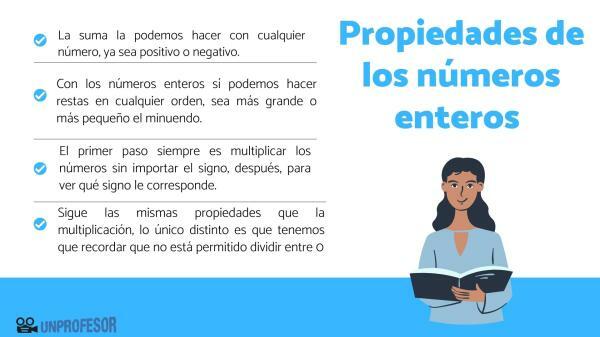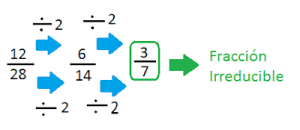Properties of integers

Today we bring you a new lesson from a Teacher, in which you will learn what are integers and what are their properties. Thus, you will find examples throughout the lesson, to make it easier to understand and, at the end, you will see some exercises that we propose and their respective solutions, so that you verify that you have acquired the knowledge necessary. We start this lesson from the properties of integers! Do not miss it.
Index
- what are integers
- What are the properties of integers
- Exercises of the properties of integers
- Solution
What are integers.
The integer numbers, known as Z, are those numbers that encompass both the natural numbers and their negative opposites, also including the number zero.
They are a infinite set of numbers with which we can add, subtract, multiply and divide. Thus, the integers are:
- 1, 2, 3, 4, 5, 6, 7, 8, 9, 10...
- Also -1, -2, -3, -4, -5, -6, -7, -8, -9, -10...
- And the number 0.
What are the properties of integers.
The properties of integers affect their operations, so let's break it down by type of operation:
Sum
The sum can be done with any number, either positive or negative. Let's see the possible cases:
- Addition of two positive numbers: we will add both numbers and the result will always be positive. For example: (+3) + (+6) = +9.
- Addition of two negatives: we will add both numbers and the result will always be negative. For example: (-5) + (-2) = -7.
- Addition of a negative and a positive number: we will make a subtraction between the largest and the smallest and we will leave the sign of the one that is larger, that is, of the first. For example: (-9) + (+2) = -7.
Subtraction
Unlike the natural numbers, with integers we can do subtraction in any order, whether the minuend is larger or smaller.
- Subtraction of two positive numbers: the second number will remain negative, we will subtract the large minus the small and we will leave the sign of the largest. For example: (+4) - (+7) = + 4 - 7 = -3.
- Subtraction of two negative numbers: the second will remain positive, we will subtract the large minus the small and we will leave the sign of the largest. For example: (-7) - (-2) = - 7 + 2 = -5.
- Subtraction of a positive number and a negative number: the second will be positive, so we will do an addition and it will be positive. For example: (+5) - (-6) = +5 + 6 = +11.
- Subtraction of a negative number and a positive number: the second will be negative, so we will add both, but the result will have a negative sign. For example: (-4) - (+6) = - 4 - 6 = - 10.
Multiplication
The first step is always to multiply the numbers regardless of the sign, then, to see which sign corresponds to it, we will follow the following properties:
- If the two numbers have the same sign, the result will be positive. That is, if both numbers are positive or both are negative, the result will always be positive. For example: (+5) x (+3) = +15. Another example would be: (-8) x (-2) = +16.
- If one is positive and the other negative, the result will always be negative. For example: (-7) x (+3) = -21.
Division
It follows exactly the same properties as multiplication, the only thing different is that we have to remember that dividing by 0 is not allowed. So, the first thing we will do is divide the numbers in the order they give us and then:
- If they both have the same sign, the result will be positive. For example, (-18): (-3) = +6.
- If the signs are different, the result will be negative. For example: (-20): (+2) = -10.

Exercises of the properties of integers.
To check that you have understood this lesson on the properties of integers, we suggest that you solve the following activities:
1. Perform the following operations:
- (-7) + (+2)
- (+3) x (+9)
- (+8) - (-2)
- (+25): (-5)
2. Is it true that if we multiply two negative numbers, the result will be positive?

Image: Tomi Digital
Solution.
Let's see how it went:
1.
- (-7) + (+2) = -7+2 = -5.
- (+3) x (+9) = +27.
- (+8) - (-2) = +8+2 = +10.
- (+25): (-5) = -5.
2. Is it true that if we multiply two negative numbers, the result will be positive?
Yes it's correct.
If you have found this article useful, remember that you can send it to your classmates and continue browsing the tabs on our website.
If you want to read more articles similar to Properties of integers, we recommend that you enter our category of Arithmetic.


